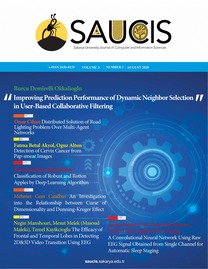Identification of Plant Species by Deep Learning and Providing as A Mobile Application
Derin Öğrenme Kullanılarak Bitki Türlerinin Sınıflandırılması ve Mobil Uygulama Olarak Sunumu
___
[1] M. Dyrmann, H. Karstoft, and H. S. Midtiby, “Plant species classification using deep convolutional neural network,” Biosyst. Eng., vol. 151, pp. 72–80, Nov. 2016, doi: 10.1016/j.biosystemseng.2016.08.024.[2] P. Barré, B. C. Stöver, K. F. Müller, and V. Steinhage, “LeafNet: A computer vision system for automatic plant species identification,” Ecol. Inform., vol. 40, pp. 50–56, Jul. 2017, doi: 10.1016/j.ecoinf.2017.05.005.
[3] G. L. Grinblat, L. C. Uzal, M. G. Larese, and P. M. Granitto, “Deep learning for plant identification using vein morphological patterns,” Comput. Electron. Agric., vol. 127, pp. 418– 424, Sep. 2016, doi: 10.1016/j.compag.2016.07.003.
[4] J. W. Tan, S.-W. Chang, S. Binti Abdul Kareem, H. J. Yap, and K.-T. Yong, “Deep Learning for Plant Species Classification using Leaf Vein Morphometric,” IEEE/ACM Trans. Comput. Biol. Bioinforma., pp. 1–1, 2018, doi: 10.1109/TCBB.2018.2848653.
[5] A. Ambarwari, Q. J. Adrian, Y. Herdiyeni, and I. Hermadi, “Plant species identification based on leaf venation features using SVM,” TELKOMNIKA (Telecommunication Comput. Electron. Control., vol. 18, no. 2, p. 726, Apr. 2020, doi: 10.12928/telkomnika.v18i2.14062.
[6] H. F. Eid and A. Abraham, “Plant species identification using leaf biometrics and swarm optimization: A hybrid PSO, GWO, SVM model,” Int. J. Hybrid Intell. Syst., vol. 14, no. 3, pp. 155–165, Mar. 2018, doi: 10.3233/HIS-180248.
[7] M. A. Islama, S. I. Yousuf, and M. M. Billah, “Automatic Plant Detection Using HOG and LBP Features With SVM,” Int. J. Comput., vol. 33, no. 1, pp. 26–38, 2019.
[8] I. Gogul and V. S. Kumar, “Flower species recognition system using convolution neural networks and transfer learning,” in 2017 Fourth International Conference on Signal Processing, Communication and Networking (ICSCN), 2017, pp. 1–6, doi: 10.1109/ICSCN.2017.8085675.
[9] M. Toğaçar, B. Ergen, and Z. Cömert, “Classification of flower species by using features extracted from the intersection of feature selection methods in convolutional neural network models,” Measurement, vol. 158, p. 107703, Jul. 2020, doi: 10.1016/j.measurement.2020.107703.
[10] M. Momeny, A. Jahanbakhshi, K. Jafarnezhad, and Y.-D. Zhang, “Accurate classification of cherry fruit using deep CNN based on hybrid pooling approach,” Postharvest Biol. Technol., vol. 166, p. 111204, Aug. 2020, doi: 10.1016/j.postharvbio.2020.111204.
[11] Y. Ren, N. Wang, M. Li, and Z. Xu, “Deep density-based image clustering,” Knowledge-Based Syst., vol. 197, p. 105841, Jun. 2020, doi: 10.1016/j.knosys.2020.105841.
[12] W. Qian et al., “UAV and a deep convolutional neural network for monitoring invasive alien plants in the wild,” Comput. Electron. Agric., vol. 174, p. 105519, Jul. 2020, doi: 10.1016/j.compag.2020.105519.
[13] K. P. Ferentinos, “Deep learning models for plant disease detection and diagnosis,” Comput. Electron. Agric., vol. 145, pp. 311–318, Feb. 2018, doi: 10.1016/j.compag.2018.01.009.
[14] Y. Osako, H. Yamane, S.-Y. Lin, P.-A. Chen, and R. Tao, “Cultivar discrimination of litchi fruit images using deep learning,” Sci. Hortic. (Amsterdam)., vol. 269, p. 109360, Jul. 2020, doi: 10.1016/j.scienta.2020.109360.
[15] J. Chen, J. Chen, D. Zhang, Y. Sun, and Y. A. Nanehkaran, “Using deep transfer learning for image-based plant disease identification,” Comput. Electron. Agric., vol. 173, p. 105393, Jun. 2020, doi: 10.1016/j.compag.2020.105393.
[16] S. Fan et al., “On line detection of defective apples using computer vision system combined with deep learning methods,” J. Food Eng., vol. 286, p. 110102, Dec. 2020, doi: 10.1016/j.jfoodeng.2020.110102.
[17] C. W. Yohannese and T. Li, “A Combined-Learning Based Framework for Improved Software Fault Prediction,” Int. J. Comput. Intell. Syst., vol. 10, no. 1, p. 647, 2017, doi: 10.2991/ijcis.2017.10.1.43.
[18] A. Krishnaswamy Rangarajan and R. Purushothaman, “Disease Classification in Eggplant Using Pre-trained VGG16 and MSVM,” Sci. Rep., vol. 10, no. 1, p. 2322, Dec. 2020, doi: 10.1038/s41598-020-59108-x.
[19] M. F. Adak, “Modeling of Irrigation Process Using Fuzzy Logic for Combating Drought,” Acad. Perspect. Procedia, vol. 2, no. 2, pp. 229–233, Oct. 2019, doi: 10.33793/acperpro.02.02.34.
[20] Y. LeCun, K. Kavukcuoglu, and C. Farabet, “Convolutional networks and applications in vision,” in Proceedings of 2010 IEEE International Symposium on Circuits and Systems, 2010, pp. 253–256, doi: 10.1109/ISCAS.2010.5537907.
- ISSN: 2636-8129
- Yayın Aralığı: Yılda 3 Sayı
- Başlangıç: 2018
An Evaluation of VGG16 Binary Classifier Deep Neural Network for Noise and Blur Corrupted Images
Adding Virtual Objects to Realtime Face Images; A Case Study in Augmented Reality
Analysis of the Covid-19 Impact on Electricity Consumption and Production
Sentiment Analysis for Software Engineering Domain in Turkish
Identification of Plant Species by Deep Learning and Providing as A Mobile Application
Energy Saving and Life Cycle Analysis of a Daylight-Linked Control System
Ceyda AKSOY TIRMIKÇI, Cenk YAVUZ
Estimation of Constant Speed Time for Railway Vehicles by Stochastic Gradient Descent Algorithm
Analysis of Different Types of Network Attacks on the GNS3 Platform
